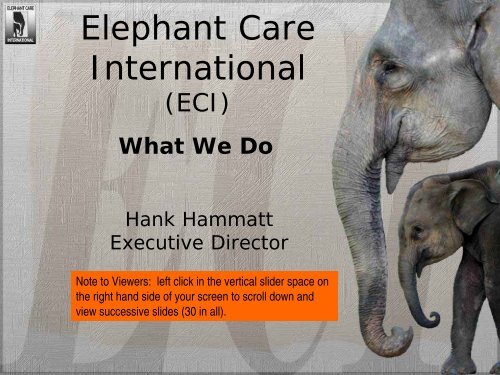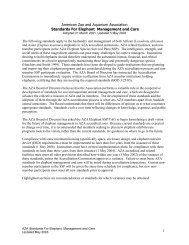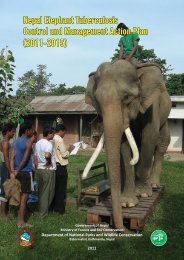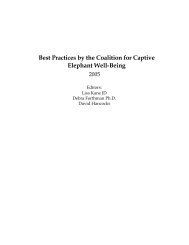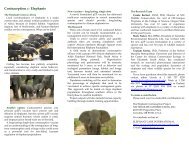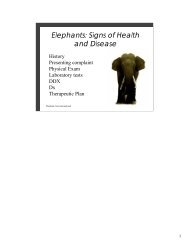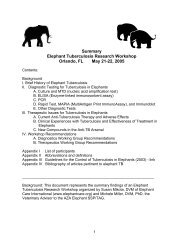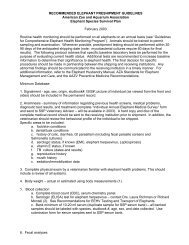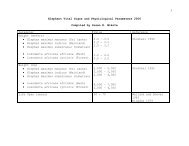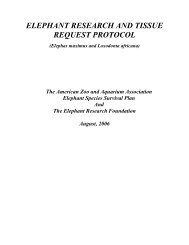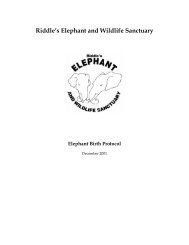What We Do.pdf - Elephant Care International
What We Do.pdf - Elephant Care International
What We Do.pdf - Elephant Care International
You also want an ePaper? Increase the reach of your titles
YUMPU automatically turns print PDFs into web optimized ePapers that Google loves.
ECI - <strong>What</strong> <strong>We</strong> <strong>Do</strong>• Projects in the U.S., Asia, Africa• Work with captive and wild elephants• <strong>Elephant</strong> healthcare and conservation• Provide information &financial resourcesfor professionalsImage © and used with permission of Piers Locke
ECI Goals• Support direct healthcare• Further our knowledge of diseases.• Facilitate cooperation,collaboration & communication• Implement community-basedsolutions for HEC• Inspire broader conservation issues.
ECI Projects• <strong>Elephant</strong> Tuberculosis Initiative– Nepal / India• Africa: Alternative to Culling• Sri Lanka: Community-BasedConservation• <strong>Elephant</strong> Publications• Resources for <strong>Elephant</strong>Professionals• Sumatran <strong>Elephant</strong>Healthcare & Conservation
<strong>Elephant</strong> Tuberculosis Initiative• Validate diagnostic techniques• Improve treatment methods• Establish a surveillance systemand database• Goal: Survey Asian elephantrange countries by 2015Image © and used with permission of Melanie Faith <strong>Do</strong>ve
Nepal TB Project• Examined 120 elephants• Validated new serologicaltests• Assessment andtreatment plan• Permanent healthcareprogramNepal
India TB Project• 800 elephants - largest elephanthealthcare project ever• Test for TB and other diseases• All India veterinarian team undersupervision by R. Sukumar PhD• Technical support by ECI• Funded by ECI, with support inIndia by CUPA & WSPAImage © and used with permission of Philippe Coste
Africa - Alternative to CullingU. Bechert, M. Fraker, G. Kerley• Overabundance ofAfrican elephants• Alternative vs. culling,starvation, habitat loss• Long lasting singledose contraceptive• Years of testing req’d.Botswana, © Scotch Macaskill used with permission
Sri Lanka Project• Community–based conservation• Alternative crops in corridors of high HEC• Partnership with Sri Lanka Wildlife ConservationSociety
<strong>Elephant</strong> Publications• <strong>Elephant</strong> Biology,Medicine, and Surgery, thefirst modern elephant care text book• Sumatran <strong>Elephant</strong>s inCrisis―Time for Change,S. Mikota, H. Hammatt, andY. Fahrimal, a book chapter in<strong>Elephant</strong>s and Ethics (in press)• Many journal articles
Our website
<strong>We</strong>bsite Professional Content• <strong>Elephant</strong> HealthcareDatabase• The <strong>Elephant</strong> Formulary• Bulletin Board• <strong>Elephant</strong> Protocols,Manuals, & Standards• Disease Fact Sheets• Pharmacies• Vital Signs and Physiological Values for <strong>Elephant</strong>s
<strong>Elephant</strong> Healthcare DatabaseAnatomy & PhysiologyAnesthesia & RestraintBehavior, Training &EnrichmentCaptive ManagementCardiovascularConservation & EcologyCulture, History, &EvolutionDental & TuskDiagnostic TechniquesDiseases, BacterialDiseases, ViralDiseases, other infectiousDiseases, non-infectious &unknown etiologyEndocrinologyGastrointestinalGeneticsHematology, SerumChemistry / Normal ValuesImmune SystemIntegumentLaws, Regulations, &GuidelinesMedicine, GeneralMusculoskeletalNeonatal & Hand-rearingZoonoses & Human InjuryNeoplasiaNervous SystemNutritionParasitismPathologyPharmacologyRenal & UrinaryReproductionRespiratorySpecial Senses &Chemical CommunicationSurgeryTreatment Techniques<strong>We</strong>lfareZoonoses & Human Injury
<strong>Elephant</strong> Formulary• Drug MonographsIndex• Ophthalmic Products• Medication Techniques• CompoundingPharmacies
<strong>Elephant</strong> Formulary• Tables of ParenteralFluids• Abbreviations Used InPrescription Writing• Solubility Definitions• Conversion Tables• Millequivalents &Molecular <strong>We</strong>ights• Conversion ofConventional ChemistryUnits to SI Units• Simple Formula forDiluting Solutions• Monographs sorted bytherapeutic class /indication• Bibliography for originalPlumb work• References for originalPlumb work
<strong>Elephant</strong> FormularyDrug Mongraphs A-Z• AcepromazineMaleate *• Acetazolamide• Acetic Acid• Albendazole• Albuterol Sulfate• Altrenogest• Amikacin Sulfate• Tylosin• Vitamin E/Selenium• Warfarin Sodium• Xylazine HCl *• Yohimbine HCl• Zinc• Zuclopenthixol
Protocols, Manuals, and Standards
Protocols, Manuals, and Standards
Diseases of <strong>Elephant</strong> –Fact sheets• Encephalomyocarditis(EMC, EMCV)• EndotheliotropicHerpesvirus(EEHV)• Rabies• Salmonellosis• Signs of Health and Disease• Tetanus• TuberculosisImage © and used with permission of Philippe Coste
<strong>Elephant</strong> Bulletin BoardYour document or image could be posted here
Sumatra - <strong>Elephant</strong> Healthcare &Conservation Project• Worked in Sumatra 2000-2003• Under unpaid auspices of WWF• Goal to improve healthcare and conservation• Encountered corruption and callous disregard• Collected data revealing 85% mortalityamong government-captured elephants• Indonesia government harassment – hastyescape• Continue to work for change >
Of 117 <strong>Elephant</strong> Captures in Riau,Sumatra Sept. 2000 – Feb. 200362 confirmed dead4 died later4 reported as “lost” (likely dead)39 translocated / expected to die109 elephants dead, lost, or likely to dieA known death rate of at least 85 percent
Wild <strong>Elephant</strong> Populationsin Riau, Sumatra 1990-2006• 1990 1100-1700• 2000 600-700• 2006 350
Publications on the Sumatran Crisis• Occurrence and prevention of capture wounds in Sumatranelephants (Elephas maximus sumatranus). Mikota, S. K., Hammatt,H., and Finnegan, M., Proceedings American Association of ZooVeterinarians. 291-293. 2003.• Implications of New Data for Sumatran <strong>Elephant</strong>s in Captivity-Time for Change, H. Hammatt, Drh Y. Fahrimal, S. Mikota DVMProceedings of the <strong>International</strong> Symposium on Human-<strong>Elephant</strong>Relationships and Conflicts, Sri Lanka 2003• <strong>Elephant</strong> Injuries and Deaths, Riau Province Indonesia,July 2000 - June 2003, A report to the Government of Indonesia byMikota and Hammatt• Sumatran <strong>Elephant</strong>s in Crisis―Time for ChangeS. Mikota, H. Hammatt, and Y. Fahrimal, a book chapter in<strong>Elephant</strong>s and Ethics (in press)• plus many other presentations and reports• See also www.elephantcare.org/sumshort.htm
Additional projects• Small grants program• Open access elephantmedical image library• Open access PowerPointcollections on elephanthealthcareImage © and used with permission of Philippe CosteLaosImage © and used with permission of Philippe Coste
Position Statement<strong>We</strong> welcome diverse viewpoints.The strong opinions that elephants evoke caneither be useful, driving one to greater efforts tosave the species, or they can be counterproductive.If we allow ourselves to be blindedby our convictions, we may at best fail to seebeneficial aspects of other positions and, atworst, contribute to the demise of the creatureswe seek to save.
ECI Projects - recap• <strong>Elephant</strong> Tuberculosis Initiative– Nepal / India• Africa: Alternative to Culling• Sri Lanka: Community-BasedConservation• <strong>Elephant</strong> Publications• Resources for <strong>Elephant</strong> Professionals (website)• Sumatran <strong>Elephant</strong> Healthcare & ConservationImage © and used with permission of Melanie Faith <strong>Do</strong>ve
Thank You!Please consider a donationto help us help the elephants!Image © and used with permission of Genny Dumonceaux
Please use the “Back” buttonon the upper left of your browserwindow to return to our website.


